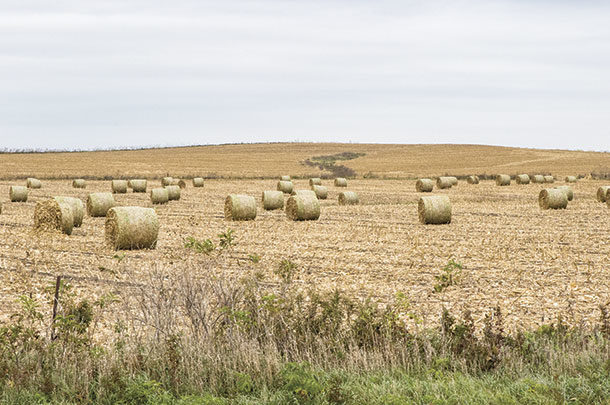Baled corn residue is just corn residue, right? As with many things, it all depends. Baled corn residue is often a low-cost source of roughage in the Midwest. Its feed value, though, can be increased with use of selective harvest methods or ammoniation, making corn residue an even more valuable feed resource.
Value depends on harvest method
The most common harvest method is the rake and bale system. However, there are at least three other options we have researched. First is the EZ bale system, where the combine tailings are dropped in a windrow behind the combine, and then the windrow is baled, including the tailings and two rows of stalks.
The EZ bale system excludes the raking step, which reduces the cost of raking and reduces yield. The rake and bale system removes about two-thirds of the residue and the EZ bale about one-third (about 3.8 and 1.9 tons as-is per acre for a 200-bushel-per-acre field).
Equipment manufacturers have produced two systems we have experience with. First is the New Holland Cornrower system, where an attachment to the cornhead cuts two, four, six or eight rows of stalks and places them in a windrow where the tailings are dropped. This replaces the raking step. When eight rows are windrowed, the yield is similar to rake and bale, and when two rows are windrowed, the yield is similar to the EZ bale system.
The second system is the Hillco-John Deere MOG baler system. MOG is “material other than grain,” which is the tailings from the combine; we usually call it husklage. The equipment connects the combine to a trailing baler that bales the tailings as the combine moves through the field while harvesting corn.
The yield of husklage in the system is less than the Cornrower or EZ bale system because no stalks are harvested, yielding 25 percent of residue (1.4 tons per acre on a 200-bushel-per-acre field).
Custom rates for baling are about $15 per bale or about $25 per ton as-is. Raking is about $10 per acre or about $2.65 per ton. While it takes twice as many acres, we assume combine and baling costs are the same as in the rake and bale systems, so $2.65 is saved in the EZ bale system. Similar costs per ton would be expected in the Cornrower and Hillco-John Deere systems – somewhere between the $25 and $27.65 per ton of as-is baled material.
Corn residue is about 45 percent stem, 31 percent leaf, 15 percent cob and 9 percent husk. Digestibility is opposite the amount, with husk being greatest and stem least. Therefore, harvest methods that minimize stem produce higher-quality residue. Combine tailings are about 42 percent cob, 27 percent leaf, 17 percent husk and 14 percent upper stem.
We have conducted feeding studies with residues from the four harvest systems, but not at the same time. Rake and bale stalks were included in all studies, so results are reported relative to rake and bale stalks. Residues were fed to growing calves at 62 to 65 percent of the diet with wet distillers grains and supplement.
Compared to rake and bale stalks, husklage feeding increased calf gains by 25 percent, two-row (Cornrower) feeding increased gains by 11 percent, and EZ bale feeding increased gains by 4 percent. This illustrates the differences due to harvest method and the value of decreasing stem in the harvested residue.
Corn yields continue to increase
The ratio of residue to grain has remained fairly constant, so more residue is produced as well as grain. This greater amount of residue presents a challenge for planting subsequent corn or soybeans. Therefore, some shredding or tillage operation is often used. Tillage may have short-term benefits but may decrease soil organic matter over time and may increase erosion.
Therefore, removing some of the residue for cattle feed by harvesting or grazing actually reduces need for tillage or shredding. Harvesting the residue removes plant nutrients, primarily nitrogen and phosphorus.
The value of those nutrients is about $5 per ton of as-is residue (more if potassium is replaced). If harvest eliminates the need for shredding, about $2 per ton is saved. Therefore, the actual costs of baled residue are about $28 to $30.65 per ton as-is. Price discovery then determines the price paid from the cattleman to the corn producer.
How much residue one should remove from the field depends on several agronomic factors, including soil organic matter and erosion. The four harvest systems discussed removed 25 to 67 percent of the residue. Therefore, choices can be made on a harvest system that fits with agronomic needs for the amount of residue to be left on the field.
Ammoniation can make a good value even better
Ammoniation has been used for decades to improve the energy value (digestibility) of low-digestibility forages and has the added benefit of increasing the crude protein (CP)content of the forage. In the trials where growing calves were fed a diet containing nonammoniated residue versus ammoniated residue, ammoniation increased calf gains from 1.66 to 2.77 pounds per day.
In these trials, the performance response was due to an increase in digestibility (energy value) coupled with increased intake.
Past research has shown cobs respond well to ammoniation. Therefore, it was expected harvested residues with greater percentages of cobs would respond better to ammoniation. This was generally true, but the differences were small and not statistically significant. However, it was found that effects of selective harvest and ammoniation were additive, meaning they can be combined for optimal effect.
Overall, ammoniating corn residue increases the digestibility by about 10 percent units and the CP by about 5 percent units. Thus, traditional corn residue bales that are ammoniated are about 55 to 58 percent total digestible nutrients (TDN) and will have a CP content of 9 to 11 percent.
Currently, the cost of ammoniation is only about $25 per ton (which includes anhydrous ammonia, plastic, labor and machinery). When combined with harvesting costs, this puts the costs at about $50 to $60 for a feed equal in value to that of medium-quality hay.
Recently, we conducted a study to determine the amount of waste if corn residue was fed in a round bale feeder. Ammoniation significantly increases the palatability of corn residue, and feeding cows only resulted in 16 to 20 percent waste, which is only slightly higher than estimates with hay at 13 to 15 percent. Thus, producers without the ability to mix diets can take advantage of this low-cost feed resource and feed it just like hay.















